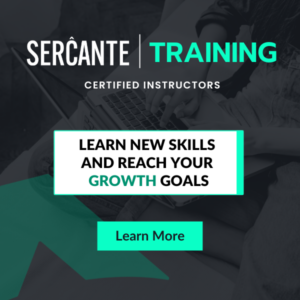It’s not a secret, so many growth teams, marketing, sales, and customer success, want to be using AI to streamline processes and elevate customer experiences, but when it comes to adoption, they’re a little stuck on how to get started with AI.
After hearing a few of the experts at Sercante share their insights and having conversations with marketing leaders who have taken the plunge on applying AI to their initiatives, plus some first-hand experience with our own marketing, I was able to create this collection of tips for how to get started with AI.
For those thinking, TLDR, let’s cut to the chase, I recommend downloading Sercante’s AI Starter Kit.
Tip 1: Pinpoint the pain
After attending a Connections 2025 Recap Webinar, Sercante’s Salesforce Product Director, Heather Rinke, advised the audience to get started with AI by writing down the biggest pain points they have today.
What is a manual, repetitive, and mundane task, sucking up your bandwidth?
Then consider, of those pain points, which is the lowest barrier to entry? What might have dependencies that might need a little more technology configuration, data setup, or the involvement of multiple departments?
Focus on the low lift, but quick-win initiatives first. Often, this would be an internal process that you could see how it performs, measure impact, and then scale from there.
[Watch On-Demand 2025 Connections Recap]
Tip 2: Do your research
As Laura Curtis, Senior CRM & Marketing Automation Strategist at Sercante said on the Connections Recap, “You don’t know what you don’t know.”
In fact, 71.7% of non-adopters say “lack of understanding” is their biggest barrier to AI adoption (Influencer Marketing Hub AI in Marketing Benchmark Report). So if you’re feeling overwhelmed, you’re not alone. But it’s also fixable.
One way to start doing your research: Download the Sercante AI Starter Kit. It’s full of:
- Real use case examples
- Tips you can steal
- Customer stories
- Common pitfalls to avoid
Also, check out Rinke’s article, Five Tips for Getting Started with Agentforce.
Tip 3: Try out-of-the-box tools first
Don’t build the Death Star on day one.
There’s zero need to spin up a complex custom solution to get started. Many platforms—especially Salesforce Agentforce—already have out-of-the-box agents and AI functionality you can activate right now.
Use them.
Start small. Test how it works. See how it helps. Then decide if you want to scale or customize.
Tip 4: Get your data house in order (but don’t wait for perfect)
As Sercante VP of Growth & Alliances, Lauren Noonan, shared on the Connections Recap, “Very few people buy a home and it’s perfect.”
You can start with AI even if your data isn’t a 10/10. But the better your data hygiene, the better your AI output.
Start by asking:
- What data is critical for our first use case?
- Where does it live?
- What’s messy that could block us?
Then clean it as you go. Consider what other data optimizations you can make along the way to support the future AI initiatives on your roadmap. Like updating the kitchen before you renovate the whole house, and then mapping out what renovations make sense to do next.
Tip 5: Measure what matters
But what metrics are worth tracking to measure the impact of AI?
It depends on your use case, but as an example, Noonan shared the idea of using AI to generate a campaign brief instead doing it manually.
How long does it take you to do it manually versus using AI?
Before getting started with using AI internally, get benchmarks for how long it typically takes your team do the processes you’ll be using AI for and then measure how long it takes after.
Now, the bigger question that Noonan posed is “What are you going to do with the time you get back and how will it impact the organization?”
If you’re trying to champion AI in your organization and get your leaders on board to support the initiative, answering questions like these can be a huge part of the business case—other than the increased efficiency, maximized output, and better customer experiences that’ll lead to growth.
Tip 6: Taking a crawl, walk, run approach to AI
As the CMO of Mogli, Christina Scarmeas, shared on my recent conversation with her on the Innovator Series about her team’s approach to using AI and Agentforce:
“One of the biggest things we learned was, it’s okay to slow down and take a crawl, walk, run, approach to AI. Take a step back, look at the infrastructure that we need to deploy, and what we’re trying to do with these agents. Be okay with having a phased approach with expectations of how it’s going to be implemented, and if you put that infrastructure together and have a team that is dedicated to the strategy behind it, the results come fast.”
This aligns with Rinke’s advice of starting with an initiative that is low-barrier-to-entry, perhaps something internal where you can point to productivity gains.
A customer in the healthcare industry’s story of getting started with AI
For example, one of Sercante’s customers in the healthcare industry serving multiple practices implemented Service Agents with Salesforce Agentforce.
The Service Agents were set up to help the human agents query knowledge faster to support them in their calls to better serve patients and providers.
The solution has been rolled out to one practice area first, so the team can continue to learn and adapt the solution as needed before scaling to their other practice areas.
This is a great instance of a team starting small, with rolling out an AI-powered solution in one area of their business to then evaluate and see how it can be applied to the other areas of their business..
Tip 7: Build your AI roadmap
Once you’ve dipped your toe in, it’s time to zoom out.
As the Director of Marketing at Mogli, Evan Thomas shared on the Innovator Series:
“AI is the next evolution of technology and like all the tools that came before it, you have to have a plan. Just getting AI into your org isn’t going to fix it. You have to have a plan for that AI. What is it going to do for you? What is the process it is going to supplement or help your team focus on? What is the reason you’re doing it?”
Creating your AI Roadmap for quick wins and long-term success
Therefore, the next step is creating your plan or your AI roadmap. Identifying your pain points and use cases is the first step of this. The other piece of this is evaluating the customer lifecycle through the lens of the customer and identifying points of friction that could benefit from a solution to help your team scale and make the engagement seamless. However, as this can be overwhelming for teams to do, experts have started collaborating to put together resources for this.
Sercante’s session, AI Roadmap: The Strategy for Driving Growth with AI, is a great resource that includes insights from experts on how to approach creating a plan that:
- identifies high-impact use cases
- considers dependencies and how to address roadblocks
- outlines key metrics to track for measuring success
- clearly defines your path for quick wins and long-term success
Take advantage of training opportunities for creating your AI plan
Another option for getting started with creating your AI Roadmap is to get training. According to SurveyMonkey, 70% of employers don’t provide training on AI, even though 70% of marketers say it’s essential. Therefore, any time you can get training and advance your skills on how to approach AI or how to use it, take advantage!
One training offered is Sercante’s AI Workshop: Building your roadmap for real impact. This is the deep dive where the experts will guide you through creating your 30-60-90 day plan to help your organization get started with AI and scale for the future.
One last thing: Pick yourself in this era
CEO of Sercante, Andrea Tarrell, shared this sentiment during her opening keynote at MarDreamin’ Summit, encouraging the community to take action asking, “If not you, then who?”
This technology is at our fingertips, and it’s up to us to decide how we’re going to use it to streamline processes, meet customers where they are at scale, and create a truly seamless experience.
It’s time to get started with AI.








